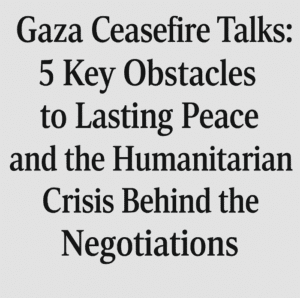Gaza Ceasefire Talks: 5 Key Obstacles to Lasting Peace and the Humanitarian Crisis Behind the Negotiations
Gaza ceasefire talks are inching forward, with Qatar facilitating delicate negotiations between Israel and Hamas, though deep divides persist. Hamas demands a five-year truce, Israeli withdrawal, and hostages’ release, while Israel insists on hostage exchanges without ending the war. Amidst stalled talks, Gaza’s humanitarian crisis intensifies, with food supplies exhausted and the death toll surpassing 52,000. Political rifts grow, as Palestinian Authority President Abbas challenges Hamas, while regional players like Turkey and Egypt seek to mediate. The fundamental issues of statehood, security, and governance remain unresolved, leaving Gaza in a perilous state. Despite some progress, the path to lasting peace seems elusive, with cycles of violence threatening to persist without a comprehensive solution.

Gaza Ceasefire Talks: 5 Key Obstacles to Lasting Peace and the Humanitarian Crisis Behind the Negotiations
The prospect of a ceasefire in Gaza remains fragile, with Qatar signaling cautious optimism following high-stakes negotiations. While incremental progress has been reported, fundamental disagreements between Israel and Hamas continue to stall a resolution, leaving civilians trapped in a devastating humanitarian crisis and a political vacuum. Here’s a breakdown of the latest developments and their implications:
Qatar’s Mediation: A Delicate Balancing Act
Qatari Prime Minister Sheikh Mohammed bin Abdulrahman Al Thani described “slight progress” after meeting with Mossad chief David Barnea, emphasizing that both sides still lack alignment on ending the war. Qatar, a longtime mediator, faces immense pressure to bridge gaps:
- Hamas’s New Demands: The group now seeks a five-year truce, Israeli withdrawal from Gaza, and release of all hostages in exchange for disarmament—a significant shift from previous positions.
- Israel’s Stance: Netanyahu’s government insists on hostage releases without committing to ending the war or accepting Palestinian governance in Gaza.
This deadlock highlights the chasm between immediate humanitarian needs and long-term political solutions.
Humanitarian Catastrophe Deepens
As talks stall, Gaza’s 2.1 million residents face unprecedented suffering:
- Food Supplies Exhausted: The UN World Food Programme warns its Gaza food stocks are depleted, accusing Israel of using starvation as a tactic—a claim Israel denies.
- Rising Death Toll: The Hamas-run Health Ministry reports over 52,000 fatalities, though independent verification remains challenging due to access restrictions.
International law mandates Israel ensure aid reaches civilians, yet aid groups describe bureaucratic delays and unsafe conditions as major barriers.
Political Maneuvering: Abbas’s Gambit and Hamas’s Isolation
Palestinian Authority (PA) President Mahmoud Abbas took a rare step by appointing Hussein al-Sheikh as his PLO deputy, hinting at succession planning. His fiery condemnation of Hamas—labeling them “sons of dogs” and demanding hostage releases—underscores deepening fissures:
- PA’s Bid for Relevance: The U.S. and regional actors push for a reformed PA to govern post-war Gaza, but Netanyahu rejects this, preferring indefinite Israeli security control.
- Hamas’s Concessions: In a notable pivot, Hamas expressed willingness to cede governance to a “Palestinian entity,” potentially opening doors for PA involvement.
Yet, mutual distrust between Hamas and Fatah, coupled with Israel’s opposition, complicates any unified governance structure.
Regional Dynamics: Turkey and Egypt’s Roles
Turkey’s Foreign Minister Hakan Fidan noted Hamas’s growing “receptiveness” to talks after meetings in Doha, while Egypt continues backchannel diplomacy. Both nations aim to leverage influence, but their efforts clash with Israel’s strategic goals and U.S. priorities.
The Path Ahead: Obstacles and Opportunities
Key unresolved issues perpetuate the cycle of violence:
- Ceasefire vs. “Total Victory”: Israel prioritizes dismantling Hamas, while Hamas bets on international pressure from Gaza’s suffering to force concessions.
- Governance Void: Without a credible Palestinian leadership plan, power struggles risk prolonging instability.
- Hostage Dilemma: Families of remaining captives intensify pressure on Netanyahu, but his coalition relies on hardliners opposing deals with Hamas.
Conclusion: A Crisis with No Easy Exit
While Qatar’s mediation offers a sliver of hope, the war’s root causes—Palestinian statehood, security guarantees, and reconciliation—remain unaddressed. The immediate focus on aid access and hostage releases could build trust, but without a shared vision for Gaza’s future, cycles of violence are likely to persist. The international community’s ability to hold both parties accountable for civilian protection and negotiate compromises may determine whether this “slight progress” evolves into lasting peace.
You must be logged in to post a comment.